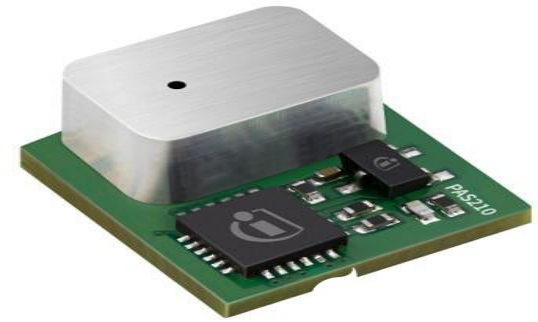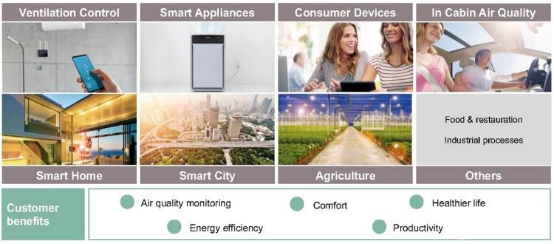What are the challenges in developing sensors?
Infineon CO2 sensors integrate photoacoustic transducers, detectors, infrared light sources and filters on a single printed circuit board. The sensor has a small microcontroller for on-board signal processing, complex algorithms, and a MOSFET for driving infrared light sources. The modulated infrared light source will radiate into the mixed gas in the sampling chamber. After CO2 absorbs infrared light, it will heat up and increase the pressure in the sampling chamber. The pressure change can be measured by a MEMS microphone.

Infineon's compact Xensiv PAS CO2 sensor
During the development of the PAS-CO2 sensor, the main challenge was to maximize the performance of the microphone and minimize system noise; that is, isolate the MEMS detector from external noise to detect only the CO2 molecules from the cavity. Pressure changes. Infineon modeled the response of the MEMS microphone before manufacturing the prototype device to verify the modeling results.
Advantages of Infineon's PAS CO2 sensor solution
Infineon's newly launched Xensiv PAS CO2 sensor in 2019 uses an IM69D130 Xensiv MEMS microphone with a signal-to-noise ratio of 69 dB. The sensor is designed for scenarios with low self-noise, wide dynamic range, low distortion, and high acoustic overload points. Thanks to the above advantages of IM69D130, the gas sensor can measure even the slightest pressure fluctuations, so even a small amount of gas is sufficient to accurately determine the gas concentration. Therefore, the sampling chamber can also be designed very small. Compared with traditional CO2 sensors with the same performance (true CO2 measurement), the size of the new sensor is reduced by more than 75%. The integrated microcontroller converts the MEMS microphone output signal into ppm readings, which can be obtained through three serial I2C, UART, or PWM interfaces. Direct ppm readings, surface mount, and simple design make it easy and fast to integrate digitally with flexible production. All internal components are developed and designed to Infineon's high quality standards.
The sensor is very rugged, with a measurement range of 0 ppm to 10,000 ppm and a measurement accuracy of up to 5000 ppm (± 3% of reading or ± 30 ppm of accuracy). Its operating temperature range is 0 ° C to 50 ° C and relative humidity is 0% to 85% (non-condensing). The drift value is less than 1% per year (active self-calibration). The design life of the CO2 sensor in pulse mode is 10 years. Xensiv PAS CO2 has these excellent properties, making it an ideal choice for demand-oriented ventilation control in smart buildings and indoor air quality control in smart home applications.

Xensiv PAS CO2 sensor typical application
Infineon is planning to introduce several variants of the sensor to meet the special needs of various applications, such as low power consumption in battery-powered applications, smaller size, lower cost for portable devices, and extremely demanding industrial applications Need to be more reliable. The development of other gas sensors is also planned by Infineon.
If you want to know more, our website has product specifications for the sensors, you can go to ALLICDATA ELECTRONICS LIMITED to get more information

